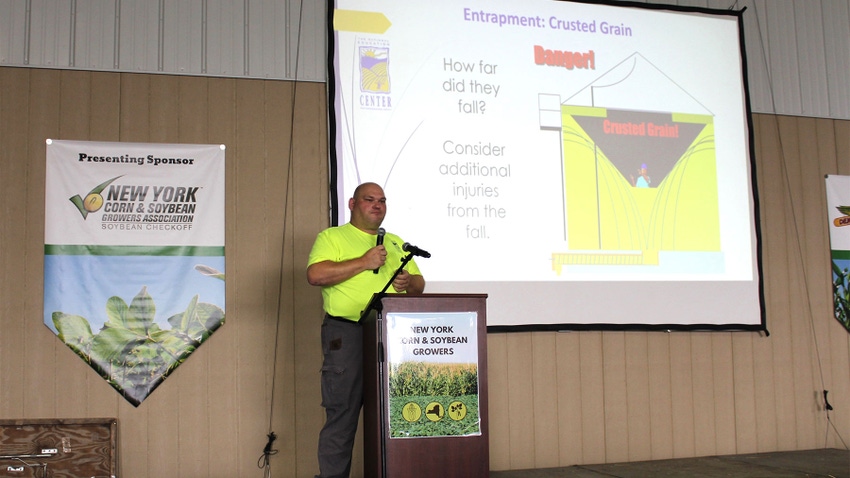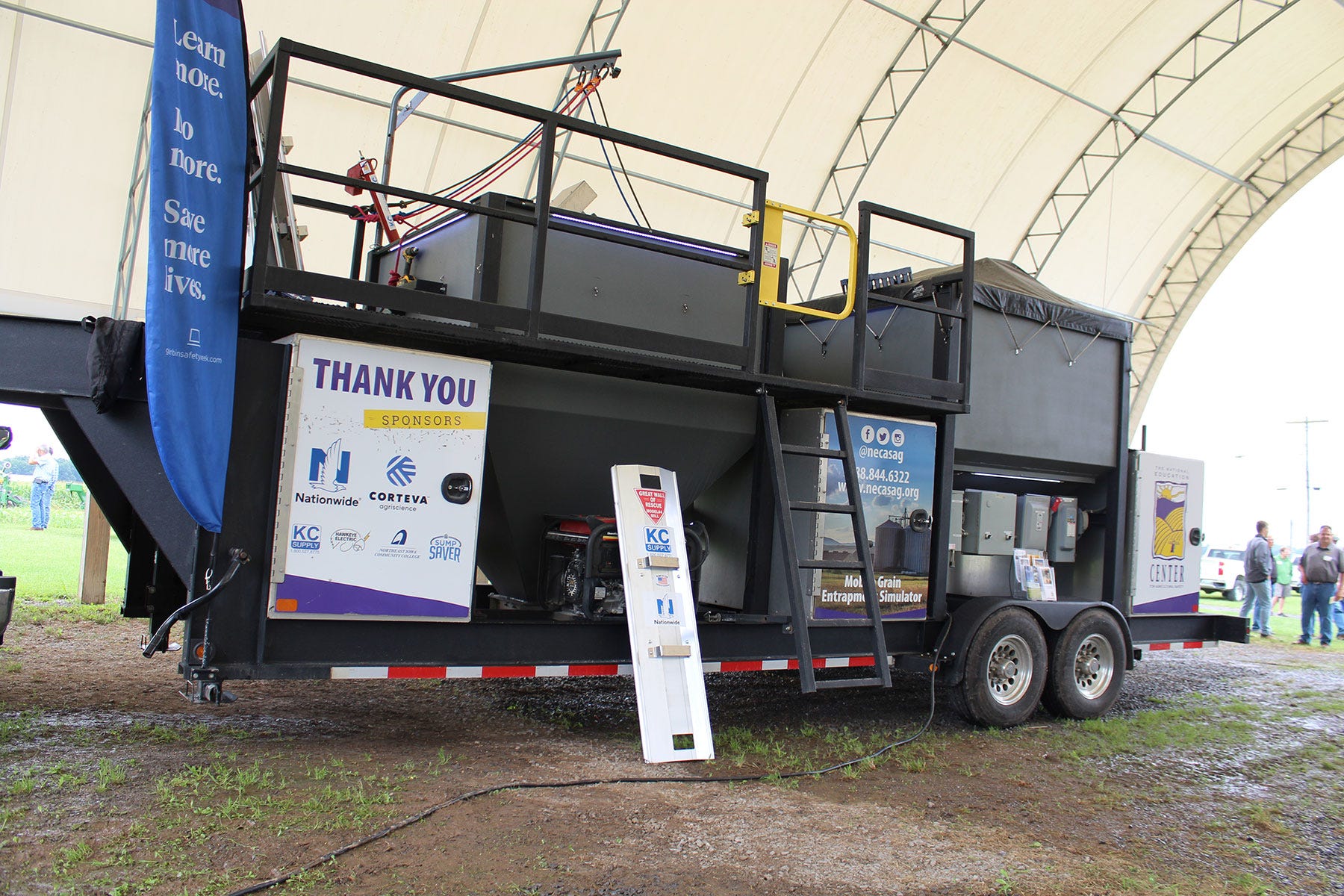August 31, 2023

In the blink of an eye, you or a loved one could suffer a debilitating or deadly farm accident.
According to the U.S. Bureau of Labor Statistics, workers involved in agriculture, forestry, fishing and hunting were involved in 50,900 nonfatal occupational injuries and illnesses, and 511 fatalities in 2020. And that doesn’t include farms with fewer than 10 employees, which tend to have less stringent safety rules and precautions.
“Farming is the most dangerous occupation today,” said Brian Freese at the recent New York Corn and Soybean Growers Association’s Summer Crop Tour. “We’ll never hit zero accidents in my lifetime.”
Freese is a rescue and safety instructor from the National Education Center for Agriculture Safety. He has traveled to 19 states since April, making similar presentations to farmers and rescue personnel. NECAS is based in Peosta, Iowa, but the organization’s reach includes Delaware, Pennsylvania and Ohio, as well as other Midwest states.
Part of the reason for grain bin accidents is typical farm procedure.
“We’re not storing grain properly, not using safety equipment,” he said. “OSHA rules don’t apply on the family farm with fewer than 10 employees. But you can apply them.”
Purdue University’s Agricultural Safety and Health Program showed that in 2022, no fewer than 83 cases of farm injuries involved confined spaces on farms, resulting in 24 deaths and 59 injuries. That represents a 40.7% increase from 2021, the highest number of grain entrapments reported in more than a decade.
“Confinement” refers to moving parts and pinch parts that can injure farmers.
Freese said that many farmers do not keep farm chemicals in their original containers or maintain material safety data sheets.
“That escalates the scene quite a bit” during a rescue, he said.
Another complication is when a rescue team can’t get to an entrapped farmer. Freese said that farms should maintain a clear pathway to buildings and bins, and ensure driveways are suitable for equipment to use. Soft shoulders and narrow passages won’t work, he noted.
Freese said that PTOs and other such equipment are big contributors to entrapments. He talked about an incident where a farmer’s manure spreader got jammed. Rather than cut off power before attempting to free the jam, he climbed up on top and kicked it. Unfortunately, the jam freed abruptly, and the spreader pulled him through, killing him.
Rollovers on tractors can also be dangerous. Freese noted that many farmers either do not properly or consistently use rollover protection structures, or they lack them altogether. Some use ROPS but without seat belts, which negates much of its protection.
“People are driving around with the bucket up, and that changes the center of gravity,” he said. “Ninety-nine percent of rollovers are with ROPS folded down. Rollovers are still the No. 1 cause of death on the farm.”
Confinement accidents, such as in a grain bin, manure pit or open-air lagoon, are dangerous because of lack of oxygen.
Don’t assume a quick rescue
Many people assume that emergency personnel will respond quickly to rescuing an entrapped farmworker. However, Freese said such rescues take about 3.5 hours because of the time it takes to set up equipment, the time it takes to drive to a rural location, assessing how to safely attempt the rescue and performing the rescue.
“Sinking happens much quicker than people realize,” Freese said of grain bins rescues. And they are hard to do. “A couple guys can’t just pluck him out of the grain” as the pounds of pressure are too heavy, he added.

ENTRAPMENT SIMULATOR: Having the ability to demonstrate the difficulty of rescuing a person from a grain bin entrapment helps Freese teach farmers about the dangers grain bins present.
Freese talked about an entrapment accident in February 2022 just outside Mount Vernon, Iowa. It took seven fire departments, two ground ambulance agencies, one air ambulance, five law enforcement agencies, the Mount Vernon Public Works personnel, a vacuum truck from Cedar Rapids Public Works, Iowa Department of Transportation personnel, River Valley Co-op’s grain vacuum, Global Water Services vacuum truck, and several pieces of farm equipment — including a skid loader, tractor and shovels — to rescue one trapped farmworker.
“If you go into a confined space, you need someone watching,” he said, adding that the watcher can help spot dangers and, if an accident does occur, can get help quickly.
If working in or around a grain bin, Freese said it is important to know appropriate tie-off points, and to use harnesses and approved ladders. Tying a handrail or handle is not enough.
“Galvanized metal will not keep you from falling,” he said. “Anchors need to be installed by the manufacturer.”
Watch your grain
Another grain bin hazard is when the top of the grain becomes crusted. This layer can abruptly collapse, entrapping a worker.
“Put grain away at the proper moisture level and stir it up,” Freese said. “There isn’t a good way to get in there and rescue you without knocking down more grain on you.”
Typically, rescuers cut large holes in the side of grain bins to gradually release the grain.
“The only way to prevent these accidents is to stay out of the bins,” Freese said.
Grain avalanches are another farm hazard, as they can knock people down easily.

INSTALLING ROPS: Tractors with rollover protection systems such as this one at Rodman Lott & Son Farms provide more protection to farmers than tractors lacking them. However, many farmers still do not use ROPS properly, or even have them installed.
“Grain vacuums have killed farmers,” Freese said. “It can take grain right out from under you if you set it down. Warning labels are there for a reason.”
Unfortunately, though, most farmers seldom read them.
“If the sweep auger’s running, you’re not supposed to go in there,” he added.
Prevent a disaster
When calling emergency personnel, a farmer should know how to accurately describe the situation, where it is happening and how personnel can access the area. They should also describe conditions causing the emergency, such as if the person is fully or partially submerged, and the number of victims. Sometimes, additional farmworkers become victims in failed rescue attempts.
Freese said that farmers should label electrical panels for emergency responders, and maintain clean, dust-free panels. Unmaintained panels can hamper rescue efforts.
“Shop vac the dust off the electrical panel and put a cover on it,” he said. And don’t turn on the auger if a worker gets trapped in a bin.
Things that can complicate a rescue
Here are the top things Freese said will often complicate a farm emergency rescue:
Location. Farmers typically work alone, a considerable distance from rescuers, and often where only all-wheel-drive vehicles can go but firetrucks are too large.
Work conditions. Farms have places that are confined along with heavy machinery, animals and chemicals.
Farmer fatigue. Farmers work long hours every day of the year, which can increase the risk of accidents.
Farmers are older. The average age of a farmer is 58 years old. Advanced age can increase sensory loss and slow reaction time.
Children are around. Farmers work and live on the farm with their families. Children can be found in many places on the farm, and they are usually not trained in proper safety protocol.
Sergeant writes from central New York.
Read more about:
Farm SafetyAbout the Author(s)
You May Also Like




